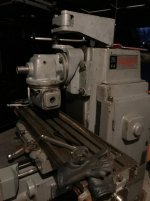Brandenberger
Hot Rolled
- Joined
- Sep 19, 2017
Hi,
I picked up a K&T universal fixed head for my 205 SA. This is the non-quill type, 50taper spindle, but with an intermediate adjustable "knuckle."
It was on a machine in the AZ desert for some time, and I was concerned that it might have some sand/grit in it.
I've pulled apart the sections, which actually all look pretty good, lots of solidified grease but no sand infiltration.
Now I'm looking at the spindle... I took the back cover off and again there doesn't seem to be any grit that made it into the top bearings. The spindle is stiff but feels like just old grease.
I pumped in new grease, which displaced some of the old, but not very much of it. I removed the rear threaded retainer ring and the roller bearings look good, the old grease seems free of grit (witness marking the retainer rotational position).
However, I pumped grease also into the front / lower spindle bearings, and water was ejected from the spindle nose. So I'm wondering if I should remove the spindle, and if so, how is the bevel gear preload / position set in these heads?
It looks like there are "fitting washers" in the parts diagram on either side of the bevel gear, leading me to believe as long as those go back where they were, the preload should go back together without any particular adjustment.
Thanks,
Phil
I picked up a K&T universal fixed head for my 205 SA. This is the non-quill type, 50taper spindle, but with an intermediate adjustable "knuckle."
It was on a machine in the AZ desert for some time, and I was concerned that it might have some sand/grit in it.
I've pulled apart the sections, which actually all look pretty good, lots of solidified grease but no sand infiltration.
Now I'm looking at the spindle... I took the back cover off and again there doesn't seem to be any grit that made it into the top bearings. The spindle is stiff but feels like just old grease.
I pumped in new grease, which displaced some of the old, but not very much of it. I removed the rear threaded retainer ring and the roller bearings look good, the old grease seems free of grit (witness marking the retainer rotational position).
However, I pumped grease also into the front / lower spindle bearings, and water was ejected from the spindle nose. So I'm wondering if I should remove the spindle, and if so, how is the bevel gear preload / position set in these heads?
It looks like there are "fitting washers" in the parts diagram on either side of the bevel gear, leading me to believe as long as those go back where they were, the preload should go back together without any particular adjustment.
Thanks,
Phil






